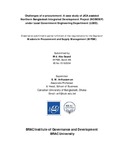Challenges of e-procurement: a case study of JICA assisted Northern Bangladesh Integrated Development Project (NOBIDEP) under Local Government Engineering Department (LGED).
Abstract
Procurement is the acquisition of goods, works or services through externally sourcing. In
sourcing, the needs of the organization for goods, works or services including requirement
definition, identification of potential suppliers, schedule of requirement etc. are taken into
account. E-procurement is the acquiring of goods, works or services through on-line bidding
from potential suppliers. Public procurement means procurement using public funds.
Public procurement systems in Bangladesh has been evolved, modified and developed over
time. Chronologically milestones of the processes are PPR 2003, PPA 2006 & PPR-2008. E-GP
system is launched in Bangladesh by the year 2011 which results public procurement more
accessible, fair, transparent and efficient. Objective of this paper is to identify the challenges
of e-GP through a case study of JICA assisted NOBIDEP project implemented by LGED and
recommends measures to be adopted by the concern stakeholders in their arenas. For this
purpose, a Questionnaire survey has been conductedamong the different stakeholders of
LGED, bidders’ community& others in collecting primary data. Besides, Key Informant
Interview has been carried out to collect valuable opinions of some senior officials; their
perception regarding the challenges of e-Procurement and suitable suggestions to
overcome negative impacts. The summary of each chapter is summarized below:
The Chapter One termed as Introduction illustratesthe background of e-GP system in
Bangladesh covering public procurement reform and the evolution of e-GP system. The
Chapter Two titled as Literature Review explains the worldwide e-procurement issues like its
adoption, operations, benefits, challenge & risks etc. It also explains how e-GP in Bangladesh
weregradually adopted and become successful with special attention to LGED, Bangladesh.
The Chapter Three Titled as Methodology of study describes how the study was carried out
including coverage area, sample size and data collection using the designed
questionnaire.The Chapter Four Termed as Data Analysis represents the data gathered from
different respondents in bar diagrams using excel spread-sheet. The bar diagrams are selfexplanatory.
The Chapter Five Tilled as Findings illustrates E-GP related issues like internet
connectivity, internet speed, power availability, user friendliness, Knowledge & expertize of
the personnel handling the programme, suitability of different time frame for conducting
the procurement activities, confidentiality and risks etc.
Finally, the Chapter Six terming as Conclusion & Recommendation includes conclusions
about the different challenges of e-Procurement and a set of recommendations that
different Organizations and Government could do to overcome those challenges.

